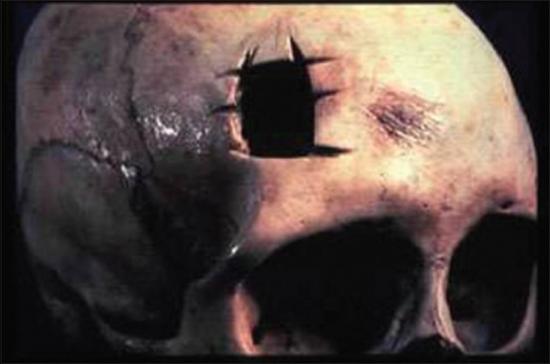Ross Pomeroy
Source http://www.realclearscience.com/blog/2016/03/why_did_ancient_humans_cut_open_their_skulls.html?
 San Diego Museum of Man
San Diego Museum of Man
Archaeologists have unearthed thousands of skeletons belonging to ancient humans, and with every bone unearthed, they usually learn something new. But equally as often, the remains reveal curiosities that pile into a mounting mystery. Such is the case with trephined skulls -- skulls with holes in them.
Mind you, these are not fracture holes cause by blunt trauma, nor are they holes wrought by wear and tear over many millennia of entombment under earth and rock. These are holes that were purposely cut. Thousands of years ago, our ancestors were excising pieces of skull from the heads of men, women, and children that were likely alive at the time of the procedure.
More than 1,500 trephined skulls have been uncovered throughout the world, from Europe and Asia to North America and South America. So common are these craniums that five to ten percent of all skulls from the Neolithic Period -- ranging from roughly 4,000 to 12,000 years ago -- have holes cut into them. Miguel Faria, a retired Clinical Professor of Neurosurgery and medical historian from Mercer University, calls trephination the "oldest documented surgical procedure performed by man."
But why did our ancestors do it?
"The mystery continues to perplex medical historians," Faria noted last spring in an editorialpublished to the journal Surgical Neurology International. But he believes the mystery has actually been solved for more than twenty-five years, hidden in plain sight within an expansive, seven-part tome on the history of medicine written by medical historian Plinio Prioreschi.
Considering the tome's length, a daunting 4,292 pages, it's easy to see how such a fascinating finding could be lost amongst Prioreschi's intellectual ocean of words. But Faria conquered the literary kraken in its entirety, and was delighted to discover that Prioreschi had singlehandedly conducted an extensive analysis of skull trephination and had arrived at a fascinating hypothesis, one that Faria believes is almost certainly correct.
Prioreschi suggested that Neolithic humans cut holes into skulls in an attempt to bring injured or sickened individuals back to life. His reasoning is as follows: In the act of hunting, our ancestors would undoubtedly notice that penetrating injuries to the chest or abdomen would commonly result in death. They would also notice that blows to the head would cause a victim to enter a death-like state (what we know to be unconsciousness) and then miraculously awaken some time later. For primitive man, who -- as evidenced in cave paintings -- likely believed that death resulted from sorcery, evil spirits, or the otherwise supernatural, it might seem that the head was the key to making an individual become undead.
"More blows would not accomplish the ritual, but an opening in the head, trephination, could be 'the activating element,' the act that could allow the demon to leave the body or the good spirit to enter it, for the necessary 'undying' process to take place," Faria summarized.
"Since most Neolithic skulls were not trephined, Prioreschi further hypothesized the procedure was reserved for the most prominent male members of the group and their families," Faria added.
Faria believes that Prioreschi's deductive reasoning is sound, although confirming his hypothesis beyond a shadow of a doubt may never be possible.
Source: Faria MA. Neolithic trepanation decoded- A unifying hypothesis: Has the mystery as to why primitive surgeons performed cranial surgery been solved?. Surg Neurol Int 2015;6:72.